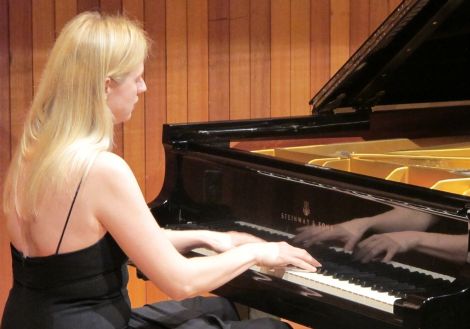|
Symphony
VSO'S CONCERT MUSIC OF TIME, MUSIC OF PLACE
by Peter Lert
Sunday, April 27, 2025
Choral and Vocal
CANTIAMO SONOMA SINGS AN INSPIRED GOOD FRIDAY MOZART REQUIEM CONCERT
by Pamela Hicks Gailey
Friday, April 18, 2025
Symphony
DRAMATIC SHOSTAKOVICH SYMPHONY CLOSES PHILHARMONIC'S 25TH SEASON
by Terry McNeill
Sunday, April 13, 2025
Recital
LARGE COLLEGE OF MARIN AUDIENCE GREETS STOPHER ARTISTRY
by Terry McNeill
Saturday, April 5, 2025
Chamber
FRISSON DELIVERS SHIVERS OF DELIGHT
by Abby Wasserman
Sunday, March 30, 2025
Symphony
OLD AND MOSTLY NEW IN SRS MARCH CONCERT IN WEILL
by Peter Lert
Saturday, March 22, 2025
Symphony
TWO FORMIDABLE SYMPHONIES AND PURPLE MOUNTAINS AT SRS CONCERT
by Peter Lert
Sunday, February 23, 2025
Chamber
THE PARKER CAPTURES DEMANDING ADES QUARTET AT RAC SEBASTOPOL CONCERT
by Peter Lert
Saturday, February 15, 2025
SPLENDID ECHOES ACROSS THE BAY
by Abby Wasserman
Sunday, February 9, 2025
ETHEREAL DUO IN WEILL HALL RECITAL
by Pamela Hicks Gailey
Thursday, February 6, 2025
|
 |
 Valentina Lisitsa Playing Chopin's Butterfly Étude Feb. 21 (R. Crockett Photo) |
LISITSA TRIUMPHS WITH BIG PROGRAM IN NEWMAN HALL RECITAL
by Terry McNeill
Sunday, February 21, 2010
Ukrainian-American virtuoso Valentina Lisitsa came to her Feb. 21 Santa Rosa recital carrying the fame of a massive YouTube video presence and as among the handful of the most popular woman pianists on the international scene. Whether she is among the best remained to be seen and heard.
Performing for the Concerts Grand series in SRJC’s Newman Auditorium, Ms. Lisitsa took on a program of staggering breadth – Schumann’s “Kinderscenen,” the Appassionata Sonata of Beethoven and the entire corpus of the Chopin Études, Op. 10 and 25. The last, along with the pianist’s undeniable glamour, attracted what was estimated to be the largest crowd ever in Newman, with many standing in the side aisles for the entire performance. Pianists and music students were liberally sprinkled throughout the audience, not really knowing how the tall artist could manage the pyrotechnics of the 24 studies after a demanding first half. They were soon to find out.
Schumann’s 13-part “Scenes from Childhood” received a poised and mildly understated reading, the singing lines perhaps most perfectly realized in the last segment, “The Poet Speaks.” Here the pianist suspended all sense of time and had the audience enthralled. For the F Minor Sonata, Op. 57, recent performances across the country seem to be emphasizing the architecture and inner connections of the movements, holding down the passion. Can one have an “Appassionata” without the passion? Ms. Lisitsa didn’t think so and played an exciting opening Allegro assai, shaking off some initial blurred passages to spotlight the sforzandos and solving with ease the difficult articulation problems in the second part of the second subject.
Ms. Lisitsa has a fluid and relaxed physical approach to the instrument, with both long arms and fingers, and in the second movement her graceful playing was a bit fast for the lyrical variations, lacking repose. The famous concluding Allegro was played ma non troppo, the thunderous 13 opening chords heralding a dramatic but controlled journey of sweeping emotion.
Turning after intermission to the daunting task of Chopin’s “exercises,” the pianist selected tempos that were almost always on the fast side. Most of the works were played “attacca,” meaning no break between each, often beginning one Étude without releasing the last note of the previous one. There is some historical support for this practice, in the original manuscripts. But no matter, as they are indeed studies brilliantly addressing a myriad of technical tasks. The highlights for this reviewer were two from the first Book, a ravishing No. 11 (Harp) and an exceptionally fast No. 12 (Revolutionary). In the second Book, the famous “Aeolian Harp” in A-Flat could have benefited by more restraint to create musical tension, as in the middle part of the Op. 25, No. 5. The “Butterfly” of Op. 25, No. 9, was played with just the right loose wrist staccato touch. Some in the hall may have felt overwhelmed hearing so much technical dexterity, but the auditing pianists were surely hanging on every familiar Étude and phrase. Overall, Ms. Lisitsa clearly preferred to play according to her concepts with no concession to digital requirements, and whether the “take no prisoners” approach works is a matter of taste. She is never, ever boring.
The expected tumult from the audience brought three generous encores, the first an unfamiliar Rachmaninoff Moment Musicaux from the 1896 set of six, Op. 16. The G Minor Prelude from the same composer’s Op. 23 was played as fast as I have ever heard it, the chords in measure 23 hammered to powerful effect while still maintaining clarity. The meno mosso middle section, described by a colleague of the composer as a reflection of his noble soul, was precipitously speedy.
Liszt’s second Hungarian Rhapsody closed the long program and of course blew the roof off. The pianist added two novel bars in mid piece and played passages where the Hungarian Liszt introduced ersatz cimbalom and finger cimbal effects with demonic abandon. Skips and repeated notes were not impeccable but distinctly resplendent. The ovation bordered on pandemonium, all of which Ms. Lisitsa accepted with unassuming grace.
Whetting the appetite of the pianist’s admirers, Santa Rosa Symphony Executive Director Alan Silow announced from his seat in the audience that Ms. Lisitsa will return in November to play Liszt’s E-Flat Concerto and Totentanz. Full houses at the Wells Center are at this early date anticipated.
The reviewer is also the producer of the Concerts Grand series.
|

